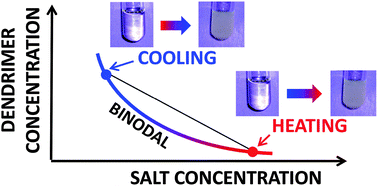Unusual liquid–liquid phase transition in aqueous mixtures of a well-known dendrimer†
Abstract
Liquid–liquid phase separation (LLPS) has been extensively investigated for polymer and protein solutions due to its importance in mixture thermodynamics, separation science and self-assembly processes. However, to date, no experimental studies have been reported on LLPS of dendrimer solutions. Here, it is shown that LLPS of aqueous solutions containing a hydroxyl-functionalized poly(amido amine) dendrimer of fourth generation is induced in the presence of sodium sulfate. Both the LLPS temperature and salt–dendrimer partitioning between the two coexisting phases at constant temperature were measured. Interestingly, our experiments show that LLPS switches from being induced by cooling to being induced by heating as the salt concentration increases. The two coexisting phases also show opposite temperature response. Thus, this phase transition exhibits a simultaneous lower and upper critical solution temperature-type behavior. Dynamic light-scattering and dye-binding experiments indicate that no appreciable conformational change occurs as the salt concentration increases. To explain the observed phase behavior, a thermodynamic model based on two parameters was developed. The first parameter, which describes dendrimer–dendrimer interaction energy, was determined by isothermal titration calorimetry. The second parameter describes the salt salting-out strength. By varying the salting-out parameter, it is shown that the model achieves agreement not only with the location of the experimental binodal at 25 °C but also with the slope of this curve around the critical point. The proposed model also predicts that the unusual temperature behavior of this phase transition can be described as the net result of two thermodynamic factors with opposite temperature responses: salt thermodynamic non-ideality and salting-out strength.


 Please wait while we load your content...
Please wait while we load your content...